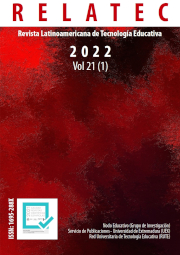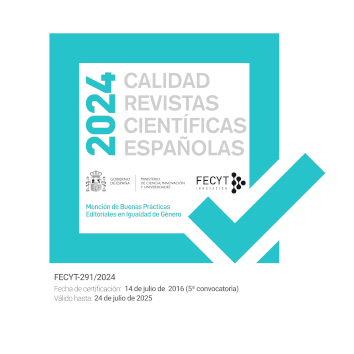Perceived learning of university students in face-to-face and b-learning courses: a comparative study
DOI:
https://doi.org/10.17398/1695-288X.21.1.115Keywords:
Learning Experience, College Students, Face-To-Face, Blended Learning, Technology Uses in EducationAbstract
The research findings regarding the level of learning in face-to-face and b-learning courses have indicated opposite results. Due to this, the present study was carried out with the aim of comparing the level of learning perceived by university students who attended courses in face-to-face and b-learning modalities (blended learning). Two hundred and nineteen students (134 women and 85 men) from different educational programs participated, 45% of the students who took courses in face-to-face mode and 54% in mixed mode (b-learning), who responded to an online instrument that measured: perception of learning acquired on the subject taken, level of development of technological skills and development of communication skills and collaborative work after completing the subject. In the results, it was found a statistically significant difference in the level of self-reported learning by students who took the class on a mixed and face-to-face modality, where the students of the face-to-face courses perceived higher learning about the subject than those who took the class in a b-learning mode. In addition, it was found that the modality described in 24% perceived learning by the students in the subjects studied.
Downloads
References
Abreu, D. C., & Sartor-Harada, A. (2021). Enseñanza y aprendizaje en entornos virtuales. Una mirada al rol del estudiante. Cenas Educacionais, 4(11610), 1-27. https://www.revistas.uneb.br/index.php/cenaseducacionais/article/view/11610/7966
Alsaaty, F. M., Carter, E., Abrahams, D., & Alshameri, F. (2016). Traditional versus online learning in institutions of higher education: Minority business students’ perceptions. Business and Management Research, 5, 31-41. https://doi.org/10.5430/bmr.v5n2p31
ANUIES. (2001). La universidad virtual en México. México: ANUIES.
Bali, S., & Liu, M. C. (2018). Students’ perceptions toward online learning and face-to-face learning courses. Journal of Physics: Conference Series, 1108(1). http://doi.org/10.1088/1742-6596/1108/1/012094
Bandara, D., & Wijekularathna, D. K. (2017). Comparison of student performance under two teaching methods: face to face and online. International Journal of Education Research, 12(1). https://bit.ly/3AiA21y
Bustos, A. & Coll, S. (2010). Los entornos virtuales como espacios de enseñanza y aprendizaje. Revista Mexicana de Investigación Educativa, 15(44), 163-184. http://www.scielo.org.mx/pdf/rmie/v15n44/v15n44a9.pdf
Cárdenas, J. M. C., & Arancibia, H. A. (2014). Potencia estadística y cálculo del tamaño del efecto en G* Power: complementos a las pruebas de significación estadística y su aplicación en psicología. Salud & Sociedad, 5, 210-244. https://doi.org/10.22199/S07187475.2014.0002.00006
Contreras, B. L., González, G. K., & Fuentes, L. H. (2011). Uso de las TIC y especialmente del Blended Learning en la enseñanza universitaria. Revista Educación y Desarrollo Social, 1, 151-160. https://doi.org/10.18359/reds.898
Domjan, M. (2010). Principios de aprendizaje y conducta. Cengage.
Esparaza, M. M. M., Salinas, U. V., & Glasserman, M. L. (2015). La gestión del aprendizaje en la modalidad b-learning frente a la modalidad presencial en la enseñanza de la gramática inglesa. Apertura, 7(2), 1-10. https://www.redalyc.org/pdf/688/68842702001.pdf
Feldman, R. S. (2005). Psicología: con aplicaciones en países de habla hispana. McGrawHill.
Fiock, H., Maeda, Y., & Richardson, J. (2021). Instructor Impact on Differences in Teaching Presence Scores in Online Courses. International Review of Research in Open and Distributed Learning, 22(3), 55–76. https://doi.org/10.19173/irrodl.v22i3.5456
García, A. L. (2019). El problema del abandono en estudios a distancia. Respuestas desde el Diálogo
Didáctico Mediado. RIED. Revista Iberoamericana de Educación a Distancia, 22(1), 245-270. https://dx.doi.org/10.5944/ried.22.1.22433
García, A. L. (2017). Educación a distancia y virtual: calidad, disrupción, aprendizajes adaptativo y móvil. RIED. Revista Iberoamericana de Educación a Distancia, 20, 9-25. DOI: http://dx.doi.org/10.5944/ried.20.2.18737
Giammateo, M. & Parini, A. (2016). El lenguaje en la comunicación digital. Universidad de Belgrano, Argentina: REUP.
Gonzales, L. E., & Evaristo, C. I. (2021). Rendimiento académico y deserción de estudiantes universitarios de un curso en modalidad virtual y presencial. RIED. Revista Iberoamericana de Educación a Distancia, 24(2). https://doi.org/10.5944/ried.24.2.29103
Hu, L.T. & Bentler, P.M. (1999). Cutoff criteria for fit indexes in covariancestructure analysis: conventional criteria versus new alternatives. Structural Equation Modeling, 6, 1-55. https://doi.org/10.1080/10705519909540118
Jarrett-Thelwell, F. D., Burke, J. R., Poirier, J. N., & Petrocco-Napuli, K. (2019). A comparison of student performance and satisfaction between a traditional and integrative approach to teaching an introductory radiology course on the extremities. Journal of Chiropractic Education, 33, 21-29. https://doi.org/10.7899/JCE-17-26
Lara, T., López, F. y Freitas, D. (2015). Las fronteras entre La educación presencial y la virtual como ampliación del campo de lo posible. Suplemento SIGNOS EAD. Brasil. https://p3.usal.edu.ar/index.php/supsignosead/article/view/3682/4562
Lloret-Segura, S., Ferreres-Traver, A., Hernández-Baeza, A., & Tomás-Marco, I. (2014). El análisis factorial exploratorio de los ítems: una guía práctica, revisada y actualizada. Anales de Psicología, 30(3). https://dx.doi.org/10.6018/analesps.30.3.199361
Neuhauser, C. (2010). Learning style and effectiveness of online and face-to-face instruction. The American Journal of Distance Education, 16, 99-113. https://doi.org/10.1207/S15389286AJDE1602_4
Nwankwo, V. I. (2013). La relación entre las percepciones de los profesores y la implementación de elementos de la teoría de la distancia transaccional y las tasas de finalización de cursos en línea [Tesis doctoral]. Florida International University.
Onrubia, J., Colomina, R. & Engel, E. (2008). Los entornos virtuales de aprendizaje basados en el trabajo en grupo y el aprendizaje colaborativo. Morata.
Raya, E. (2010). Factores que influyen en el aprendizaje. Revista Digital para Profesionales de la Enseñanza, 7. https://www.feandalucia.ccoo.es/docu/p5sd7060.pdf
Reidl-Martínez, L. M. (2013). Confiabilidad en la medición. Investigación en Educación Médica, (6), 107-111. https://doi.org/10.1016/S2007-5057(13)72695-4
Sandoval, C. (2020). La Educación en Tiempo del Covid-19 Herramientas TIC: El Nuevo Rol Docente en el Fortalecimiento del Proceso Enseñanza Aprendizaje de las Prácticas Educativa Innovadoras. Revista Tecnológica-Educativa Docentes 2.0, 9(2), 24-31. https://doi.org/10.37843/rted.v9i2.13
Schunk, D. (2012). Teorías del aprendizaje. Una perspectiva educativa. Pearson.
Semanate-Quiñonez, H., Upegui-Valencia, A., & Upequi-Valencia, M. (2021). Blended learning, avances y tendencias en la educación superior: una aproximación a la literatura. Informador Técnico, 86(1), 46 - 68. https://doi.org/10.23850/22565035.3705
Soffer, T., & Nachmias, R. (2018). Effectiveness of learning in online academic courses compared with face‐to‐face courses in higher education. Journal of Computer Assisted Learning, 34. https://doi.org/10.1111/jcal.12258
Sotelo, M. (2017). Evaluación educativa de los cursos en modalidad mixta de una Institución de Educación Superior (Tesis doctoral). Instituto Tecnológico de Sonora.
Spiro, D. (2011). Examinar las perspectivas de los instructores y estudiantes de la interacción en línea a través del modelo de comunidad de investigación [Tesis doctoral]. Nova Southeastern University. https://www.learntechlib.org/p/129602/
Suárez, J. M., & Anaya, D. (2012). Educación a distancia y presencial: diferencias en los componentes cognitivo y motivacional de estudiantes universitarios. RIED. Revista Iberoamericana de Educación a Distancia, 7, 65-75. http://doi.org/10.5944/ried.7.1-2.1075
Tuero, E., Cervero, A., Esteban, M., & Bernardo, A. (2018). ¿Por qué abandonan los alumnos universitarios? Variables de influencia en el planteamiento y consolidación del abandono. Educación XX1, 21(2), 131-154, https://doi.org/10.5944/educXX1.20066
Vila-Couñago, E., Rodríguez-Groba, A., & Martínez-Piñeiro, E. (2020). La competencia digital de los/as preadolescentes gallegos/as antes de la pandemia: ¿y ahora qué? Revista Latinoamericana de Tecnología Educativa, 19(2). https://doi.org/10.17398/1695-288X.19.2.9
Wakil, K., Abdulfaraj, A., Sadula, A., Tofiq, D., & Nawzad, L. (2019). Performance of distance learning compared with face to face learning. Journal of Educational Science and Technology (EST), 5, 1-8. https://doi.org/10.26858/est.v5i1.7952
Downloads
Published
Issue
Section
License
Authors who publish in this journal accept the following conditions:
1. The Author retains copyright in the article. Upon acceptance of the article, the author shall grant to the Publisher the right of first publication of the article. with the dcoument registered with the Creative Commons Attribution-NonCommercial-NoDerivative 4.0 International (CC BY-NC-ND) license, which allows to third parties to use what is published whenever they mention the authorship of the work and the first publication in this journal.
2. Authors can make other independent and additional contractual agreements for the non-exclusive distribution of the article published in this journal (eg, include it in an institutional repository or publish it in a book) provided they clearly indicate that the work was published for the first time in this journal.
3. Authors are allowed and recommended to publish their work on the Internet (for example on institutional or personal pages) before and during the review and publication process, as it can lead to productive exchanges and a greater and faster diffusion of published work (see The Effect of Open Access).









